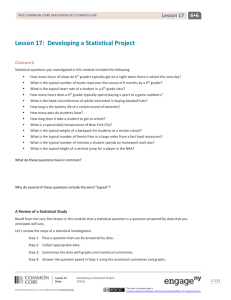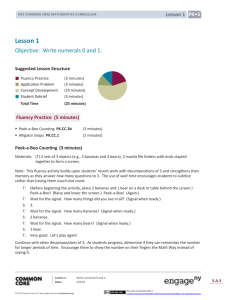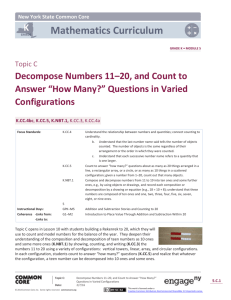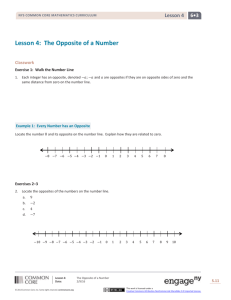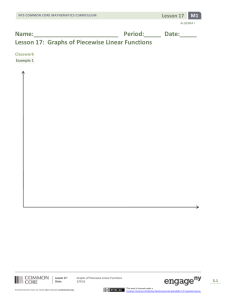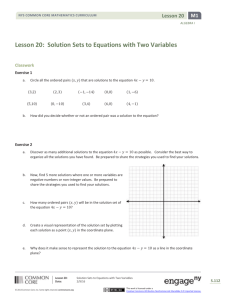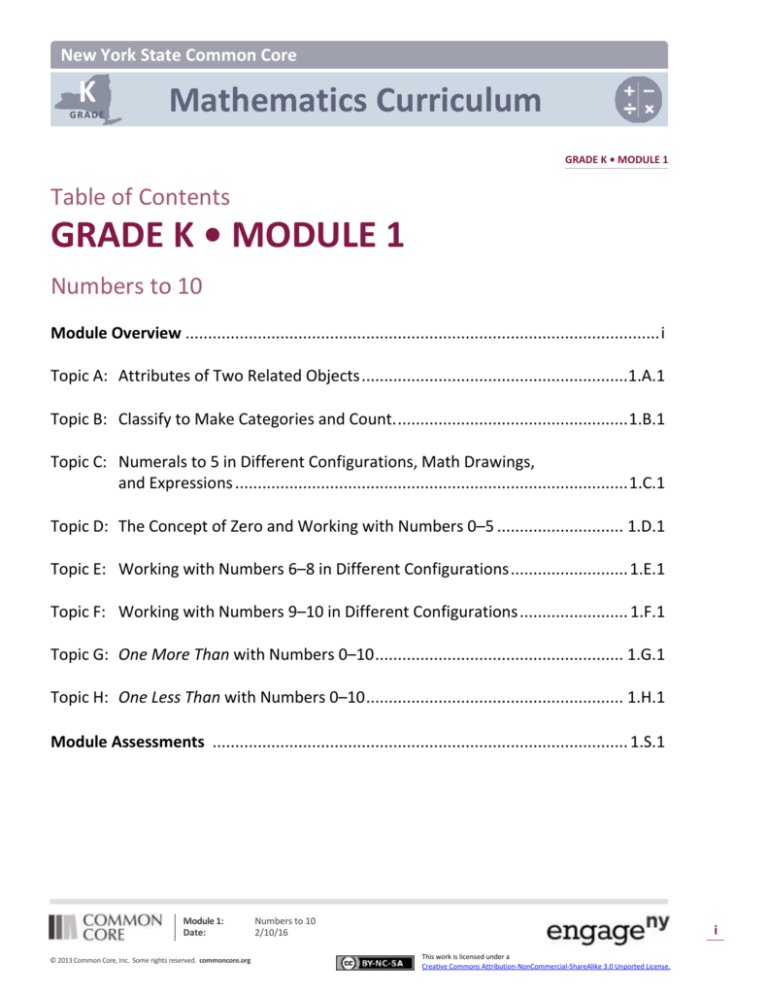
New York State Common Core
K
GRADE
Mathematics Curriculum
GRADE K • MODULE 1
Table of Contents
GRADE K • MODULE 1
Numbers to 10
Module Overview ......................................................................................................... i
Topic A: Attributes of Two Related Objects ...........................................................1.A.1
Topic B: Classify to Make Categories and Count. ................................................... 1.B.1
Topic C: Numerals to 5 in Different Configurations, Math Drawings,
and Expressions ....................................................................................... 1.C.1
Topic D: The Concept of Zero and Working with Numbers 0–5 ............................ 1.D.1
Topic E: Working with Numbers 6–8 in Different Configurations .......................... 1.E.1
Topic F: Working with Numbers 9–10 in Different Configurations ........................ 1.F.1
Topic G: One More Than with Numbers 0–10 ....................................................... 1.G.1
Topic H: One Less Than with Numbers 0–10 ......................................................... 1.H.1
Module Assessments ............................................................................................ 1.S.1
Module 1:
Date:
© 2013 Common Core, Inc. Some rights reserved. commoncore.org
Numbers to 10
2/10/16
i
This work is licensed under a
Creative Commons Attribution-NonCommercial-ShareAlike 3.0 Unported License.
NYS COMMON CORE MATHEMATICS CURRICULUM
K
Module Overview Lesson
Grade K • Module 1
Numbers to 10
OVERVIEW
The first day of kindergarten is long anticipated by parents and young students. We want students to expect
school to be a dynamic and safe place to learn, an objective that is realized immediately by involvement in
purposeful and meaningful action.
In Topics A and B, classification activities allow students to analyze and observe their world and articulate
their observations. Reasoning and dialogue begin immediately. “These balloons are exactly the same.”
“These are the same but a different size.” As Topic B closes, students recognize cardinalities as yet one more
lens for classification (K.MD.3). “I put a pencil, a book, and an eraser, 3 things, in the backpack for school; I
put 5 toys in the closet to keep home.” From the moment students enter school, they practice the counting
sequence so that when counting a set of objects, their attention can be on matching one count to one object,
rather than on retrieving the number words (K.CC.4a).
In Topics C, D, E, and F, students order, count (K.CC.1), and write (K.CC.3) up to ten objects to answer “how
many?” questions from linear, to array, to circular, and finally to scattered configurations wherein they must
devise a path through the objects as they count. Students use their understanding of numbers and matching
numbers with objects to answer "how many?" questions about a variety of objects, pictures, and drawings
(K.CC.5).
They learn that the last number name said tells the number of objects counted (K.CC.4b). Daily, they engage
in mathematical dialogue. They might compare their 7 objects to a friend’s. For example, “My cotton balls
are bigger than your cubes but when we count them, we both have seven!”
Very basic expressions and equations are introduced early in order to saturate the students with numbers
throughout the entire year so that they exit fluent in sums and differences to 5 (K.OA.5). Decomposition is
modeled with small numbers with materials, drawings, and as addition equations. Students see both the
expression 2 + 1 (Topic C) and the equation 3 = 2 + 1 (Topic D) describing a stick of three cubes decomposed
into 2 parts (K.OA.3). Emphasis is not placed on the expressions and equations, or using
them in isolation from the concrete and pictorial, but rather simply show them as
another representation of decompositions alongside counters and drawings.
In Topics G and H, students use their understanding of relationships between numbers
and know that each successive number name refers to a quantity that is one greater and
that the number before is one less (K.CC.4c). This important insight leads later in the
year, and in Grade 1, to Level 2 counting on rather than counting all.
Module 1:
Date:
© 2013 Common Core, Inc. Some rights reserved. commoncore.org
Numbers to 10
2/10/16
ii
This work is licensed under a
Creative Commons Attribution-NonCommercial-ShareAlike 3.0 Unported License.
NYS COMMON CORE MATHEMATICS CURRICULUM
K
Module Overview Lesson
In this module, daily fluency activities involving large amounts of counting (K.CC.4ab, K.CC.5) are integrated
throughout the conceptual development: “I counted 6 beans in a row. I counted 6 beans in a circle and then
squished them together and counted again. There were still 6!” “I can make my 6 beans into rows and there
are no extras.” Students complete units of 5 using the fingers of their left hand and “5-groups.” The numbers
6, 7, 8, and 9 are introduced relative to 5: “Five fingers and ____ more.” Students also explore numbers 5 to 9
in relation to 10, or 2 complete fives: “9 is missing 1 to be ten or 2 fives.” (K.OA.4)
As students start to master writing numbers to 10, they practice with paper and pencil. This is a critical daily
fluency that may work well to close lessons, since management of young students is generally harder towards
the end of math time. The paper and pencil work is calming, though energized.
Module 1:
Date:
© 2013 Common Core, Inc. Some rights reserved. commoncore.org
Numbers to 10
2/10/16
iii
This work is licensed under a
Creative Commons Attribution-NonCommercial-ShareAlike 3.0 Unported License.
NYS COMMON CORE MATHEMATICS CURRICULUM
K
Module Overview Lesson
Focus Grade Level Standards1
Know number names and the count sequence.2
K.CC.3
Write numbers from 0 to 20. Represent a number of objects with a written numeral 0–20
(with 0 representing a count of no objects).
Count to tell the number of objects.3
K.CC.4
K.CC.5
Understand the relationship between numbers and quantities; connect counting to cardinality.
a.
When counting objects, say the number names in the standard order, pairing each object
with one and only one number name and each number name with one and only one
object.
b.
Understand that the last number name said tells the number of objects counted. The
number of objects is the same regardless of their arrangement or the order in which they
were counted.
c.
Understand that each successive number name refers to a quantity that is one larger.
Count to answer “how many?” questions about as many as 20 things arranged in a line, a
rectangular array, or a circle, or as many as 10 things in a scattered configuration; given a
number from 1–20, count out that many objects.
Understand addition as putting together and adding to, and understand subtraction as taking
apart and taking from.4
K.OA.3
Decompose numbers less than or equal to 10 into pairs in more than one way, e.g., by using
objects or drawings, and record each decomposition by a drawing or equation (e.g., 5 = 2 + 3
and 5 = 4 + 1).
Classify objects and count the number of objects in each category.
K.MD.3
Classify objects into given categories; count the numbers of objects in each category and sort
the categories by count. (Limit category counts to be less than or equal to 10.)
1
In this module, work is limited to within 10.
The balance of this cluster is addressed in Module 5.
3
K.CC.4d is addressed in Module 6.
4
The balance of this cluster is addressed in Module 4.
2
Module 1:
Date:
© 2013 Common Core, Inc. Some rights reserved. commoncore.org
Numbers to 10
2/10/16
iv
This work is licensed under a
Creative Commons Attribution-NonCommercial-ShareAlike 3.0 Unported License.
K
Module Overview Lesson
NYS COMMON CORE MATHEMATICS CURRICULUM
Foundational Standards
PK.CC.1
Count to 20.
PK.CC.2
Represent a number of objects with a written numeral 0–5 (with 0 representing a count of no
objects).
PK.CC.3
Understand the relationship between numbers and quantities to 10; connect counting to
cardinality.
a.
When counting objects, say the number names in the standard order, pairing each object
with one and only one number name and each number name with one and only one
object.
b.
Understand that the last number name said tells the number of objects counted. The
number of objects is the same regardless of their arrangement or the order in which they
were counted.
c.
Understand that each successive number name refers to a quantity that is one larger.
PK.CC.4
Count to answer “how many?” questions about as many as 10 things arranged in a line, a
rectangular array, or a circle, or as many as 5 things in a scattered configuration; given a
number from 1–10, count out that many objects.
PK.CC.6
Identify “first” and “last” related to order or position.
Focus Standards for Mathematical Practice
MP.2
Reason abstractly and quantitatively. Students represent quantities with numerals.
MP.3
Construct viable arguments and critique the reasoning of others. Students reason about
other students’ ways of counting fingers or a scattered set of objects, the former by comparing
the fingers counted and the order counted or the latter by comparing counting paths through a
set of up to 10 scattered objects.
MP.4
Model with mathematics. Students model decompositions of three objects as math drawings
and addition equations.
MP.7
Look for and make use of structure. Students use the 5-group to reason about numbers within
10.
MP.8
Look for and express regularity in repeated reasoning. Students build a number stair to
reason about 1 more and 1 less than each number within 10.
Module 1:
Date:
© 2013 Common Core, Inc. Some rights reserved. commoncore.org
Numbers to 10
2/10/16
v
This work is licensed under a
Creative Commons Attribution-NonCommercial-ShareAlike 3.0 Unported License.
NYS COMMON CORE MATHEMATICS CURRICULUM
K
Module Overview Lesson
Overview of Module Topics and Lesson Objectives
Standards
Topics and Objectives
K.MD.3
A
K.CC.4a
K.CC.4b
K.MD.3
K.CC.4a
K.CC.4b
K.CC.5
K.OA.3
K.MD.3
K.CC.3
K.CC.4a
K.CC.4b
K.CC.5
B
C
Days
Attributes of Two Related Objects
Lesson 1:
Analyze to find two objects that are exactly the same or not
exactly the same.
Lesson 2:
Analyze to find two similar objects—these are the same but….
Lesson 3:
Classify to find two objects that share a visual pattern, color, and
use.
Classify to Make Categories and Count
Lesson 4:
Classify items into two pre-determined categories.
Lesson 5:
Classify items into three categories, determine the count in each,
and reason about how the last number named determines the
total.
Lesson 6:
Sort categories by count. Identify categories with two, three,
and four within a given scenario.
Numerals to 5 in Different Configurations, Math Drawings, and Expressions
Lesson 7:
Sort by count in vertical columns and horizontal rows (linear
configurations to 5). Match to numerals on cards.
Lesson 8:
Answer how many questions to 5 in linear configurations (5group), with 4 in an array configuration. Compare ways to count
5 fingers.
Lesson 9:
Within linear and array dot configurations of numbers 3, 4, and 5
find hidden partners.
Lesson 10:
Within circular and scattered dot configurations of numbers 3, 4,
and 5 find hidden partners.
Lesson 11:
Model decompositions of 3 with materials, drawings, and
expressions. Represent the decomposition as 1 + 2 and 2 + 1.
D The Concept of Zero and Working with Numbers 0–5
Lesson 12:
Understand the meaning of zero. Write the numeral 0.
Lesson 13:
Order and write numerals 0–3 to answer how many questions.
Lesson 14:
Writer numerals 1–3. Represent decompositions with materials,
drawings, and equations, 3 = 2 + 1 and 3 = 1 + 2.
Lesson 15:
Order and write numerals 4 and 5 to answer how many
questions in categories; sort by count.
Module 1:
Date:
© 2013 Common Core, Inc. Some rights reserved. commoncore.org
3
3
5
5
Numbers to 10
2/10/16
vi
This work is licensed under a
Creative Commons Attribution-NonCommercial-ShareAlike 3.0 Unported License.
NYS COMMON CORE MATHEMATICS CURRICULUM
Lesson 16:
K.CC.3
K.CC.4a
K.CC.4b
K.CC.5
K.MD.3
K.CC.3
K.CC.4a
K.CC.4b
K.CC.5
E
F
K
Module Overview Lesson
Write numerals 1–5 in order. Answer and make drawings of
decompositions with totals of 4 and 5 without equations.
Mid-Module Assessment: Topics A–D (Interview style assessment: 3 days)
3
Working with Numbers 6–8 in Different Configurations
Lesson 17:
Count 4–6 objects in vertical and horizontal linear configurations
and array (i.e., 3 and 3, 3 twos) configurations. Match 6 objects
to the numeral 6.
6
Lesson 18:
Count 4–6 objects in circular and scattered configurations.
Count 6 items out of a larger set. Writer numerals 1–6 in order.
Lesson 19:
Count 5–7 linking cubes in linear configurations. Match with
numeral 7. Count on fingers from 1 to 7 and connect to 5-group
images.
Lesson 20:
Reason about sets of 7 varied objects in circular and scattered
configurations. Find a path through the scattered configuration.
Writer numeral 7. Ask, “How is your seven different than mine?”
Lesson 21:
Compare counts of 8. For example, 8 cubes or 8 cotton balls in
linear and array (i.e., 4 and 4 or 4 twos) configurations. Match
with numeral 8.
Lesson 22:
Arrange and strategize to count 8 beans in circular (around a
cup) and scattered configurations. Write numeral 8. Find a path
through the scatter set and compare paths with a partner.
Working with Numbers 9–10 in Different Configurations
Lesson 23:
Organize and count 9 varied geometric objects in linear and
array (3 threes) configurations. Place objects on 5-group dot
mat. Match with numeral 9.
Lesson 24:
6
Strategize to count 9 objects in circular (around a paper plate)
and scattered configurations printed on paper. Write numeral 9.
Represent a path through the scatter count with a pencil.
Number each object.
Lesson 25–26: Count 10 objects in linear and array configurations (5 and 5).
Match with numeral 10. Place on the 5-group dot mat. Dialogue
about 9 and 10 on the mat. Write numeral 10.
K.CC.4a
K.CC.4b
Lesson 27:
Count 10 objects and move between all configurations.
Lesson 28:
Act out result unknown story problems without equations.
G One More Than with Numbers 0–10
Lesson 29:
Order and match numeral and dot cards from 1 to 10. State 1
Module 1:
Date:
© 2013 Common Core, Inc. Some rights reserved. commoncore.org
4
Numbers to 10
2/10/16
vii
This work is licensed under a
Creative Commons Attribution-NonCommercial-ShareAlike 3.0 Unported License.
NYS COMMON CORE MATHEMATICS CURRICULUM
K.CC.4c
K.CC.2
K.CC.5
K.CC.4a
K.CC.4b
K.CC.4c
K.CC.5
K
Module Overview Lesson
more than a given number.
Lesson 30:
Exploration: Make math stairs from 1 to 10 in cooperative
groups.
Lesson 31:
Arrange, analyze, and draw 1 more up to 10 in configurations
other than towers.
Lesson 32:
Arrange, analyze, and draw sequences of quantities of 1 more,
beginning with numbers other than 1.
H One Less Than with Numbers 0–10
Lesson 33:
Order quantities from 10 to 1 and match numerals.
Lesson 34:
Count down from 10 to 1 and state 1 less than a given number.
Lesson 35:
Arrange number towers in order from 10 to 1 and describe the
pattern.
Lesson 36:
Arrange, analyze, and draw sequences of quantities that are 1
less in configurations other than towers.
Lesson 37:
Culminating task—(Materials for this task include 5-group cards
from 0–10.)
5
“Decide how to classify the objects in your bag into two groups.
Count the number of objects in each group. Represent the
greater number in various ways. Next, remove the card from
your pack that shows the number of objects in the smaller group.
Put your remaining cards in order from smallest to greatest.
Your friends will have to figure out what card is missing when
they visit your station!”
End-of-Module Assessment: Topics E–H (Interview style assessment: 3 days)
Total Number of Instructional Days
Module 1:
Date:
© 2013 Common Core, Inc. Some rights reserved. commoncore.org
3
43
Numbers to 10
2/10/16
viii
This work is licensed under a
Creative Commons Attribution-NonCommercial-ShareAlike 3.0 Unported License.
K
Module Overview Lesson
NYS COMMON CORE MATHEMATICS CURRICULUM
Terminology
New or Recently Introduced Terms
Exactly the same/not exactly the same/the same, but… (ways to analyze objects to match or sort)
Match (group items that are the same or that have the same given attribute)
Sort (group objects according to a particular attribute)
“How many” (with reference to counting quantities or sets)
Hidden partners (embedded numbers)
Counting path (with reference to order of count)
Number story (stories with add to or take from situations)
Zero (understand the meaning of, write and recognize)
Number sentence (3 = 2 + 1)
5-group
Rows/columns (linear
configuration types)
Number path
1 more (e.g., 4. 1 more is 5)
1 less (e.g., 4. 1 less is 3)
Suggested Tools and Representations
Rulers for use as a straight edge
Five dot mat
Number Path
Five and ten frame cards
Number Path
Left hand mat
2 hands mat
Numeral cards, 0–10
Dot cards 0–10
Rekenrek (Slavonic Abacus having beads with a color change at the
five.)
Problem Sets
Concrete materials in individual bags for counting and sorting (white
beans spray painted red on one side, bags of twigs, dried leaves, dry
pasta, pennies, plates/forks/spoons/cups, etc.)
Commercial concrete materials (linker cubes in tens, non-linking
cubes, square inch tiles, etc.)
Left hand mat
Rekenrek
Module 1:
Date:
© 2013 Common Core, Inc. Some rights reserved. commoncore.org
Numbers to 10
2/10/16
ix
This work is licensed under a
Creative Commons Attribution-NonCommercial-ShareAlike 3.0 Unported License.
K
Module Overview Lesson
NYS COMMON CORE MATHEMATICS CURRICULUM
Suggested Methods of Instructional Delivery
Personal White Boards
Materials Needed for Personal White Boards
1 High Quality Clear Sheet Protector
1 piece of stiff red tag board 11” x 8 ¼”
1 piece of stiff white tag board 11” x 8 ¼”
1 3”x 3” piece of dark synthetic cloth for an eraser
1 Low Odor Blue Dry Erase Marker: Fine Point
Directions for Creating Personal White Boards
Cut your white and red tag to specifications. Slide into the sheet protector. Store your eraser on the red side.
Store markers in a separate container to avoid stretching the sheet protector.
Frequently Asked Questions About Personal White Boards
Why is one side red and one white?
The white side of the board is the “paper.” Students generally write on it and if working individually
then turn the board over to signal to the teacher they have completed their work. The teacher then
says, “Show me your boards,” when most of the class is ready.
What are some of the benefits of a personal white board?
The teacher can respond quickly to a hole in student understandings and skills. “Let’s do some of
these on our personal boards until we have more mastery.”
Student can erase quickly so that they do not have to suffer the evidence of their mistake.
They are motivating. Students love both the drill and thrill capability and the chance to do story
problems with an engaging medium.
Checking work gives the teacher instant feedback about student understanding.
What is the benefit of this personal white board over a commercially purchased dry erase board?
It is much less expensive.
Templates such as place value charts, number bond mats, hundreds boards, and number lines can be
stored between the two pieces of tag for easy access and reuse.
Worksheets, story problems, and other problem sets can be done without marking the paper so that
students can work on the problems independently at another time.
Strips with story problems, number lines, and arrays can be inserted and still have a full piece of
paper to write on.
The red versus white side distinction clarifies your expectations. When working collaboratively, there
is no need to use the red. When working independently, the students know how to keep their work
private.
The sheet protector can be removed so that student work can be projected on an overhead.
Module 1:
Date:
© 2013 Common Core, Inc. Some rights reserved. commoncore.org
Numbers to 10
2/10/16
x
This work is licensed under a
Creative Commons Attribution-NonCommercial-ShareAlike 3.0 Unported License.
NYS COMMON CORE MATHEMATICS CURRICULUM
K
Module Overview Lesson
Scaffolds5
The scaffolds integrated into A Story of Units give alternatives for how students access information as well as
express and demonstrate their learning. Strategically placed margin notes are provided within each lesson
elaborating on the use of specific scaffolds at applicable times. They address many needs presented by English
language learners, students with disabilities, students performing above grade level, and students performing
below grade level. Many of the suggestions are organized by Universal Design for Learning (UDL) principles
and are applicable to more than one population. To read more about the approach to differentiated
instruction in A Story of Units, please refer to “How to Implement A Story of Units.”
Assessment Summary
Assessment
Type
Administered
Format
Standards
Addressed
Mid-Module
Assessment
Task
After Topic D
Interview with Rubric
(Numbers 1–5)
K.CC.3
K.CC.4ab
K.CC.5
K.OA.3
K.MD.3
End-of-Module
Assessment
Task
After Topic H
Interview with Rubric
(Numbers 0–10)
K.CC.3
K.CC.4abc
K.CC.5
Culminating
Task
Lesson 37
(Materials for this task include
numeral/dot cards from 0 – 10)
“Decide how to classify the objects in your
bag into two groups. Count the number of
objects in each group. Represent the
greater number in various ways. Next,
remove the card from your pack that
shows the number of objects in the smaller
group. Put your remaining cards in order
from smallest to greatest. Your friends will
have to figure out what card is missing
when they visit your station!”
K.CC.3
K.CC.4abc
K.CC.5
K.MD.3
5
Students with disabilities may require Braille, large print, audio, or special digital files. Please visit the website,
www.p12.nysed.gov/specialed/aim, for specific information on how to obtain student materials that satisfy the National Instructional
Materials Accessibility Standard (NIMAS) format.
Module 1:
Date:
© 2013 Common Core, Inc. Some rights reserved. commoncore.org
Numbers to 10
2/10/16
xi
This work is licensed under a
Creative Commons Attribution-NonCommercial-ShareAlike 3.0 Unported License.


